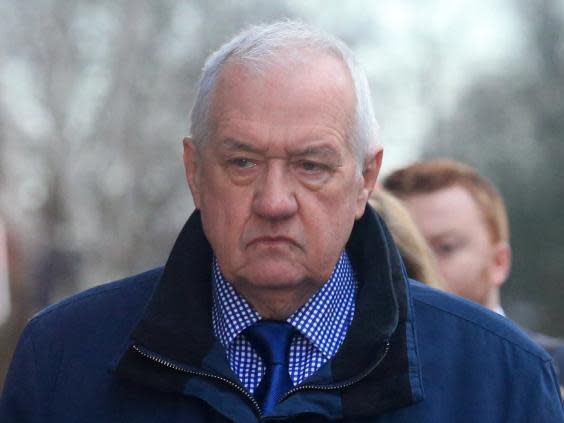Hillsborough trial: Risk of deadly crush was ‘obvious’ before disaster, court hears
The risk of Liverpool fans being crushed to death at Hillsborough was “obvious” long before the start of the 1989 FA Cup semi-final in which 96 people died, a court has heard.
A prosecutor at the trial of Hillsborough match commander David Duckenfield told Preston Crown Court that the danger was shown by a series of previous overcrowding incidents, and made worse by the failings Mr Duckenfield and Sheffield Wednesday club secretary Graham Mackrell.
“There was an obvious, serious and very present risk of death from crushing to those entering the Leppings Lane area of the stadium,” Richard Matthews QC told the jury on Wednesday.
“It involves no hindsight to recognise that if there is a need to prevent too many people from entering a particular wholly confined area, bounded by metal fencing, that is to avoid crushing and that with crushing comes the real risk of death.”
The court was played footage of the hours and minutes leading up to the disaster on 15 April 1989.
The footage showed a crush developing outside the turnstiles in Leppings Lane as Liverpool fans tried to enter the stadium in time for the 3pm kick-off.
The fenced pens behind the goal, where the disaster would unfold minutes later, were already full but prosecutors said police “did nothing” to stop more spectators from flooding in.
The court heard that lives were saved in a crush at Hillsborough stadium eight years before the disaster because gates at the front of pens three and four were opened as an escape route.
A jury deciding whether match commander David Duckenfield was responsible for the deaths of 95 victims was told police vowed to “learn lessons” from the averted tragedy in 1981.
A letter from South Yorkshire Police to the chairman of Sheffield Wednesday in June 1981 said “letting spectators onto the track was not only necessary, but was vital to avoid further serious injuries and possibly save life ... the searching examination should be in regard to why such emergency action was ever necessary”.
Police officers on duty in the 1988 FA Cup semi-final match, also played between Liverpool and Nottingham Forest at Hillsborough, said a tunnel leading to pens three and four was closed off by officers to prevent overcrowding.

But a year later, the tunnel into the pens remained open and the escape gates shut, as 96 people suffered fatal injuries.
The court also heard that Hillsborough stadium’s safety certificate had not been updated since 1979, despite changes to the layout including new fences splitting the West Terrace into pens.
An expert witness is to tell the jury that Sheffield Wednesday’s designated safe capacity for the fenced areas had been “overstated from the outset”, by thousands.
Mr Matthews said the 23 turnstiles designated to 24,000 Liverpool fans entering the stadium from Leppings Lane were not enough for them to enter safely in the time given.
He told the jury that a plan drawn up before the match made clear that 10,100 people passing through turnstiles A to G would immediately be faced with the central tunnel leading to pens three and four.
It was marked “standing” with a large sign above, and although two other tunnels to the left and right led to the terrace, the signage was too small to be seen.
Mr Matthews said that to carry out reasonable care as match commander, Mr Duckenfield should have identified the “obvious hazard” posed by the layout.
He added that an electronic counting system on the turnstiles showed that half an hour before the match, only 40 per cent of Liverpool supporters had entered the stadium but the kick-off was not delayed.
The court heard that the turnstile system had been installed “primarily to deter fraud, rather than for safety”.
Mr Duckenfield, now 74, denies gross negligence manslaughter and Mr Mackrell, 69, denies two health and safety offences.
Ninety-four of the 96 victims died on the day of the disaster, while Lee Nicol passed away as a result of his injuries two days later.
There can be no prosecution over the death of the 96th victim, Tony Bland, as he died more than a year and a day after his injuries were caused.
The trial continues.
Read our live coverage of the trial
Please allow a moment for the live blog to load

 Yahoo News
Yahoo News 